Fisher Paykel GWL11 Problem
We have a 3+ year old F&P GWL11 - it is starting to really screech during the main rinse cycle - after it drains the washing liquid and spins, it then starts to shower and rinse and it really screeches. Seems like a pump or valve problem.
We called F&P and they were no help - Appliance repair person isn't sure what is wrong and has quoted up to $500 to repair - I will buy a new one before that.
Anyone have any ideas! Thanks in advance!
Comments (232)
Tory Cory
7 years agoI've been reading this thread and trying to fix my low rinse and shower flow issue on my GW11 FP washing machine. I've made the adjustments to max in the Option Adjustment mode with a little bit more flow but not enough at all.
I recently replace both the cold and hold inlet valves as water was dripping constantly into the tub when the machine was off. That fixed the uncontrolled water issue. As I tested the machine I noticed low rinse and shower flow issue. The wash cycle has plenty of water and drains very well - just the rinse/shower is low. Any suggestions?
Thank you
dadoes
7 years agoRegards to the dripping, you confirmed both valves were bad? That's possible but unusual. The hot and cold valves are different. You obtained the correct part for both?
Regards to the shower rinsing, is the issue low flow-rate, or too-short spray time? If low flow-rate, have you visually observed that the cold water flow rate is lower during shower rinsing than during a wash (or deep rinse) fill?
The control board varies the total amount of water for shower rinsing per the load size. The setting in Option Adjustment mode is the only direct way to affect it.
Related Professionals
Four Corners Kitchen & Bathroom Designers · Oneida Kitchen & Bathroom Designers · East Tulare County Kitchen & Bathroom Remodelers · Gardner Kitchen & Bathroom Remodelers · Murray Cabinets & Cabinetry · Warr Acres Cabinets & Cabinetry · Short Hills Cabinets & Cabinetry · Honolulu Custom Closet Designers · Indianapolis Custom Closet Designers · San Diego Custom Closet Designers · Banning Flooring Contractors · Brushy Creek Flooring Contractors · East Palo Alto Flooring Contractors · Gainesville Flooring Contractors · Wyoming Flooring ContractorsTory Cory
7 years agoHi - in regards to the dripping, I did not troubleshoot to specifically which one was bad - I just replaced both. I still have both of the ones I pulled so I can still test them. When I ordered them, I provided my model number and the part numbers from the parts list and they provided the parts.
Both valves fit nicely - and looked the same except for how the wires plugged in - original they plugged in vertical and the new parts they plugged in horizontal. Washing cycle filled up and shut off with no drips just the rinse cycle.
In regards to the shower rinsing - it is definitely low flow rate; it is lower during shower rinsing than during a wash. I didn't notice a too-short spray time but I really haven't watched my machine do a full cycle normally so this could have been an issue before but I just didn't notice it. I'm attaching a video of the shower rinse.
I did max out the setting in the Option Adjustment mode. Do the inlet valves supply the water for the rinse cycle or is it recycled from the machine through a pump?
Thank you for you help.
dadoes
7 years agoAll water coming from the center spray flume is fresh from the inlet valves. Recirculation flow is only out of the port at the right/rear under the tub cover.
Flow rate in the video is definitely low.
Check the flow rates for both hot and cold via Diagnostic mode, which is full flow without any moderation that the control board may do during cycle operation.
Do you have debris screens at the faucets? There are screens in the valve connection ports but those are new with the replacement so should be good. You might check them in case some debris has collected after the replacements were done.
Did you perhaps get the replacement valves reversed during the repair?
Tory Cory
7 years agoThanks you. Since both the washer water flow and rinse water flow both come from the inlet valves - I wonder why washing is a good flow and the rinse is not. There is obviously a signal difference to the valves as they are different operations. I just don't know why one signal is working and the other one is not fully working. Either programming / signal issue from the master controller or the valves do not respond to the signal correct.
I will check the flow rates for both hot and cold via diagnostic mode.
As for the debris screens at the faucets - I do not have any - just washers. Yes, there are screens in the valve connection ports which I noticed. The hoses were drained prior to refitting which caused air in the lines. I will also check the screens. I did notice that flow is not an issue when it is in the wash cycle.
I hooked up the valves exactly as I removed them (hot to hot and cold to cold). The new valves also had the red screen for hot and the wire on the washer was labelled with a red tape for hot so it was pretty straight forward.
I'll post later after I check the flow rates and cleanliness of screens.
dadoes
7 years agoJust curious ... select the Regular cycle with Softener Rinse. Advance to the 2nd rinse light and Start. Is the flow rate for the agitated rinse fill normal or weak?
Tory Cory
7 years agoUpdate:
Checked flow rates for both valves in diagnostic mode - both were great. Hot was hot and cold was cold - flow was good.
There were difference in water flow for the rinse cycle - softener vs. no softener. Better flow with softener.
Is there some adjustment I can make beyond what I have already done? I've maxed out the rinse/shower flow already with a low flow amount - better than nothing but not optimal.
Rinse cycle without softener - no change.
Rinse cycle with sofener - good
The washing machine cycle is good flow as well:Thank you
dadoes
7 years agoNo other adjustments are available.
The control board can moderate the flow rate by rapidly pulsing power to the valves. It's apparently reducing the flow for the shower rinse. I can't say if that's deliberate operation or indication of a software malfunction.Are you experiencing unsatisfactory rinse performance? The point of the shower rinse function is to save water against a deep-fill rinse. Is it running the water long enough to thoroughly saturate the load?
Tory Cory
7 years agoThank you dadoes for this information you've been helpful and are very knowledgeable.
I'm not happy with the rinse performance - not a lot of water but I don't know what is optimal and I do want to conserve water. It is running water long enough in the 3 rinses to get everything wet but I don't know if it is enough to properly rinse it.
This may have been the performance before changing the valves and I didn't notice it since I typically just load and go.
Since I just changed the valves and they are receiving the signal and responding well for the wash cycle, maybe it is not receiving the right signal for the rinse cycle which would mean it is a point of origin error - software malfunction or controller?
Is the pulsing power similar for the wash as well as the rinse in terms of sending and receiving signal and hardware (wires, components, etc.)? Could it be a weaker signal for the rinse cycle - it sounds like the programming is designed to have it be less for water conservation.
Is there a way to test the performance of the controller?
Regards
dadoes
7 years agoThere's no procedure to test the control board. F&P does not publish specifications or software/firmware details. Only recourse is replace the board, see if there's a difference. You say that you have no reference/observation prior to the valve replacements so it may have always had a lower flow rate for eco-shower rinsing.
Slosh/squeeze a clean sock, towel, washcloth, etc. in a sink of water. Are suds generated or is the water reasonably clear?
You can select the Softener Rinse option even if not using fabric softener. That changes the rinse on the Regular and Heavy Duty cycles to an agitated deep rinse (occurs at the 2nd rinse light) instead of the eco-shower rinsing. Perm Press, Delicate, and Woolens cycles always run an agitated rinse.
Are you in California? Some F&P washers have specific models for the CA market, which may be more restricted on water use.
Tory Cory
7 years agoHi - I finally had a washing load available and was able to test.
There are a little bit of suds but overall I would say clear.
I shut it off and started it back up again and advanced to the rinse cycle. I selected warm wash and rinse to see if there would be a difference in flow. There was no water flow but it did the slow spin and humming noise.
I then shut if off and started it back up again warm wash and cold rinse and advanced to rinse cycle with with softener selected - the tub filled up nicely and there were no issues.
I'll have to try a warm wash and warm rinse with the softener to see how it fills up the next time.
The control boards are a little bit pricey and if I can get a rinse with the softener cycle that may be good enough but not ideal.
I'm in Oregon and they may have restricted the use up here but don't know.
Thanks for your knowledge and help.
dadoes
7 years agolast modified: 7 years agoYou may be confusing the five temp choices as selections for wash and rinse. They are not. The temp choices are only for wash water.
Cold = ~68°F wash temperature (or tap-cold if the Controlled Cold option is disabled in Option Settings). Cold rinse*.
Cold + Warm = ~95°F wash temperature (between warm and cold). Cold rinse*.
Warm = ~104°F wash temperature. Cold rinse*. Does not mean Warm Wash and Warm Rinse.
Warm + Hot = ~122°F wash temperature (between Warm and Hot). Cold rinse. Does not mean Hot Wash and Warm Rinse.
Hot = ~140°F wash temperature. Cold rinse.Of course, 122°F and 140°F depends on the setting of the household water heater. If the water heater is set at 120°F (which is common nowadays), then obviously the Warm+Hot and Hot temp selections can't be 122°F and 140°F.
Also, you may or may not be aware that cycles which run the Eco Active recirculation treatment** (with possible exception of Woolens*), only the initial fill for Eco Active is at the selected temperature. The remainder of the fill for the agitated wash is cold. That behavior is part of the "Eco" design of the machine.
*Woolens cycle may fill with the selected temp (limited to maximum of Warm) for both Eco Active and agitated wash to avoid thermal shock. The rinse may also be at the same temp as wash, again to avoid thermal shock which can cause shrinking of wool.
**Permanent Press cycle does not run Eco Active, it fills directly for the agitated wash period at the selected temperature but is limited to maximum of Warm.
Advancing and starting at 1st or 2nd Rinse light with Softener Rinse selected, the machine may run for a few mins without any water spray, that's normal. You have to let it run through to the final spin for the entire process.
(edited to correct "with" Softener Rinse)
Kh Aguirre
7 years agoI see that the last response was three months ago but perhaps someone can provide some guidance. I have a FP GWL11 washer. It kept stopping during the wash cycle. So I ran a diagnostic on it and the code for a blocked diverted valve came up. I removed the valve and sure enough a small straw was stuck inside the valve.
Upon reassembly the washer now beeps when powered on and the lights for diagnostic code #49 are on. I have tried unplugging the machine and checking the connections to no avail. Does anyone have advice? If you respond please know that I have never worked on an appliance before this one and you might have dumb down your response.dadoes
7 years agoThe debris inside the diverter was the only apparent problem with it, no evidence of leaking from it or the pump?
Fault 49 is an electrical problem with the cold water inlet valve. The machine "checks" the hot and cold valves immediately upon connection to power. Look inside the console for any loose wires/connectors. The cold valve is on the left, where the cold supply hose connects. Could also be that the valve coincidentally went bad. You can test it with a volt/ohm meter if you have one (and know how to use it), should read 64 ohms. Another possibility (hopefully not!) is that the motor control board went bad.
Kh Aguirre
7 years agoI didn't see any water leaking from the pump. Thank you very much dadoes. I'll pick up a volt/ohm meter tomorrow and see what that reveals.
Kh Aguirre
7 years agoSo both the hot and cold intake valves are dead. I don't know how the machine could have operated before. Is this a sign that something else happened as well?
Kh Aguirre
7 years agoI used a digital volt/ohm meter that my neighbor showed me how to use. Showed 0 as the reading.
Kh Aguirre
7 years agoWell I had someone who knew what they were doing and both read around 59 ohms. Was that enough to start the washer before I corrected the issue with the diverter valve?
Kh Aguirre
7 years agoWell I had someone who knew what they were doing and both valves read around 59 ohms. Was that enough to start the washer before I corrected the issue with the diverter valve? When I turn on the washer it automatically shows the 49 code. I can't even get the washer to power on and let me start the washer or go into diagnostic mode.
dadoes
7 years agoIt's not necessary to remove the valve from the housing to check the resistance. 59 ohms is a smidgeon low against the specification 64 ohms. F&P's electrical system is sensitive to proper resistance values throughout the machine components. +/- 5% is the typical variance ... but hard to say if 5 ohms / 7.8% is enough to throw it wonky. The two machines here, one (in garage storage, hasn't been used in several years) reads 59.x on both valves, the other that was used last week is 62.5 and 63.5. Ambient temperature has an effect, with cooler temps = slightly lower readings.
Be odd that both valves went bad simultaneously, but anything can happen. In that situation there's a possibility that the board is bad. That's why I asked about leaking at the pump (or the diverter), which can short-out and zap parts of the board. Doesn't have to be a large obvious leak. A small seeping leak over time can deteriorate the pump motor, causing an escalating electrical issue. Visually observe if there's any rusting or white-ish mineral deposits on the pump exterior.
The control board checks the valve circuits immediately upon connection to power and throws the 49 code (or 50 for the hot valve, or 48 for both ... but 49 seems to take precedence over 50 and 48). Access to diagnostics or running the machine is precluded until the valve problem is corrected.
Trace the wires between the valve(s) and board to confirm the connections are secure. Your choice is replace the valve(s) to see if that fixes the problem, then replace the board if necessary ... or replace the valves and board together for good measure. The hot and cold valves are different so be sure to get the correct parts if you replace both.
Kh Aguirre
7 years agoYou've been of tremendous help dadoes. Although I didn't see water under the washer dadoes, this is what the motor looks like.
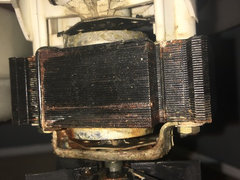
So it's pretty rusty. I have new cold and hot valves in hand but it seems to me that both the control board and the motor are the items that need to be replaced. Once I open the packages the valves they are nonreturnable.
dadoes
7 years agoThe pump is rough, should be replaced for sure. You can check the resistance on it ... remove the two-wire connector (not the green ground), should be 7 ohms across the terminals. If the reading is nominal when cool, it can change when heated from operation due to the rusting/water damage on the motor windings.
Replacing the pump is easy, no tools needed. Remove the wires. Lift the plastic thumb-latch seen at the top of your photo, rotate the entire pump counterclockwise (may take a bit of force) to detach from the mounting plate. There probably will be residual water spill out so have towels ready. Lightly lubricate the seal face with liquid detergent when remounting to ease rotating it into position.
Unfortunately, the motor control board is suspect in this case for the Code 49 moreso than the valves. Board + pump is some co$t so you have to decide on that point.
Kh Aguirre
7 years agoThank you dadoes. I agree with your assessment. If I just replace the motor could that possibly resolve everything? I think that if it's showing a code 49 and the ohms on the current h/c valves isn't that much lower than required then it's the control board that went bad. Cost on the low end to replace board and the motor is 280.00. If it's the valves too its closer to 400.00. Might as well buy a new washer if that's the case.
dadoes
7 years agoThe pump by itself can't cause the valve error, the board (or the valves) are the source of that. Do not replace the board without also replacing the pump or the bad pump will damage the new board.
The board and pump are the major components so replacing them pretty much gives you a "new"/refreshed machine. The main drive motor and display/button board rarely fails. The other components are less cost ... inlet valves (cold fails more than hot, since it's used more), diverter valve, lid lock, RPS sensor in the drive motor, off-balance switch. The pump is the "gotcha" being that it often damages the board, and the slow-leak situation isn't obvious unless the pump is examined directly to catch it ... and how often is that going to happen.
mzjula
7 years agoDadoes -- have read the entire discussion about FP GWL11 and appreciate sincerely your expertise and willingness to help. I know the pump in my machine is either shot or clogged; I think I've lost the motor control module as well. Cannot get to diagnostics -- when I plug in machine I hear a slight hum from the control panel and random diodes glow for cycles, water level, and delay start. In a dozen tries I haven't seen the same pattern twice, and get no result from Wash Temp + Power. Do you agree?
Many thanks. JP Hatam
dadoes
7 years agomzjula/JP Hatam,
Probably.
The typical sign of a bad Motor Control Board is the machine being completely dead ... but not always, depends on what specific damage occurred to the board.
The panel lights and little button switches are on a separate Display Board that mounts to the underside of the panel, which has the cycle programming and tells the Motor Control Board when to send power to the various machine components for running the functions. Display Boards don't fail very often but of course they can. Both can fail together. There are no specific tests to determine if either or both are involved (other than a dead machine always involves the Motor Board). It's largely a process of elimination. Procedure is replace the Motor Board, then also the Display Board if the problem continues.
A bad pump (or any other contributing component) MUST be replaced along with the Motor Board or the failure will recur, sometimes immediately.
Kh Aguirre
7 years agoDadoes sheI appreciate all your insight. I am heading to an appliance store today. Would you say that FP's are as well made today as they were in the early 2000's? It's a toss up between a Speedqueen and another FP.
dadoes
7 years agoF&P should be largely the same. There was a revamp of the laundry line a couple/few years ago. Haier owns majority share of F&P for a couple years but they haven't made any substantial changes in the mechanicals of the design far as I'm aware. Speed Queen is often touted as the best of the traditional-agitator toploaders, expected to last for "25 years." I've heard a few cases of early bearing failures, trouble with the belts/idlers wearing, and issues with the service network ... but many SQ owners rave that they're the best thing since anything.
Bruce Martin
6 years agoI don’t know if this thread still active. I think I have a similar problem that Tory Cory had since I have the same FP GWL11… Low water flow during the rinse cycle. However, in my case it’s so bad that the machine stops when it gets to the rinse cycle and beeps every five seconds and flashes the hot and cold water lights. The only symptom that makes any sense in the user manual that is listed is the flow rate of the supply where it is too slow. However, I checked the pressure of the water coming from the valve and it is 60 pounds. It has always been 60 pounds and I didn’t have this problem in the past. The other issue that I am having is that water is coming out of the grommet that holds the thermistor in the mixing bowl. Do you think these problems are related? Any suggestions or ideas?
dadoes
6 years agoThe inlet valves can go bad causing impaired flow rate. Rinses are always cold (except the Woolens cycle typically runs the same rinse temp selected for wash) so presumably the cold valve is the fault. Regards to the leaking thermistor seal ... fix that ASAP. The control board will short-out/fail if it gets wet from accumulation in the console tray.
Also, regards to "rinse" cycle ... there are multiple functions that occur during the Rinse 1 and Rinse 2 phases. The rinse sequence is also different on the Regular & Heavy cycles vs. the others, and Regular and Heavy change the sequence depending whether the Softener Rinse option is selected. Presumably your trouble is occurring during the fill for agitated rinse on Regular/Heavy with Softener Rinse or the other cycles. The saturation showers on Regular/Heavy without Softener Rinse do not directly measure the water flow rate or infer it via monitoring the water level in the tub.
Bruce Martin
6 years agoHi Dadoes....thanks for your help! Your point is well noted about the leaking thermistor seal. I measured the resistance of both inlet valves. They are both 58.2 ohms. FYI, I only use the "regular" cycle. Is this resistance acceptable? BTW, I put the machine in "diagnostic mode" and tested both inlet valves. They both seemed to work fine. Is it still possible either one or both of the valves are "weak"? Does the software control the rate of flow?
dadoes
6 years ago64 ohms is spec for the valves but +/- 10% so 58 is on the edge of reasonable. However the solenoid can break-down when it gets heated during use.
The flow rate is controlled primarily during wash fills when hot flow is involved so as to attain the specific selected temperature. Cold rinses are not temp-controlled (except on the Woolens cycle). Volume of water for shower rinses varies somewhat per the load size but I believe that's per spray time rather than by modulating the valve.
Lack of water flow is determined indirectly by way of the water level not increasing (fast enough) when the machine is filling. Rinse is failing completely? What are you doing about rinsing the clothes? Regular without Softener Rinse selected does not run a deep-fill agitated rinse so seems odd the 'no water' fault would occur then ... unless perhaps the very low shower level is sensed similarly to Eco Active. Or, are you selecting Softener Rinse?
Check if perhaps the drain hose is too low into the standpipe and is siphoning during rinse.
Bruce Martin
6 years agoHi Dadoes....You found the problem!!!! The drain hose was too low into the standpipe. I checked it and it extended about 4" below the F&P bracket vs. the 3/4" maximum. It is weird because it has been this way for 13 years and never did this before. Perhaps the drain pipe is partially clogged and now the water backs up a little higher in the standpipe allowing the siphoning to occur. I'll have to look into that.
As to the other problem of the leaking thermistor seal, I have wrapped some Teflon tape around the seal to"fatten" it up since it probably shrunk with age so it won't leak. I also noticed that F & P didn't put a #8 sheet metal screw in the center of the mixing chamber which would have provided a little more stability to it.
Needless to say, my wife didn't think I would be able to get it fixed. She didn't know I had a genius helping me. Have a great day!!!
HU-387661680
3 years agoHi Dadoes, I'm wondering if you are still watching this thread. I have an FP IWL16. I had a leaking pump and replaced it with a new one which came with the fuse which I carefully wired into the control board. I was working on the machine outside and only had a water hose available for testing which I connected to the cold inlet valve. There was no hose connected to the hot inlet. I ran a cold wash and it went through its cycle successfully with no leak from the new pump. I then reinstalled the machine in the laundry connecting both hot and cold hoses. The machine failed to start and threw a code 49. I tested both solenoids and got 0 ohms. I ordered a new part with the new solenoids but I'm reluctant to install it without knowing what caused both solenoids to go bad. Do you have any ideas what could have caused both to go bad or any troubleshooting advice? Any help would be gratefully appreciated.
dadoes
3 years agoWhat led to the pump replacement? Leaking? Not unusual (unfortunately) that a leaking/wet pump causes damage to the motor board that can manifest in various ways ... including damage to non-pump circuit(s) on the board and possibly to components on said circuit(s).
The hot and cold solenoids should read 64 ohms (+/- 10%) when at room temperature (not heated from operation). If reading zero then they are bad. Whether it's coincidental to the pump and the board is OK is an unknown until the valves are changed to see what happens. The power output from the board to the valves varies between 13 and 22 volts DC (not AC) and is may not read accurately.
HU-387661680
3 years agoThank you for replying. The pump was replaced because there was a slight leak.I don't believe it created a short as the machine worked with cold water after the new pump was installed. I put in a new solenoid group and verified that the resistance measurements were in range (I got 61 on the cold solenoid and 64 on the hot). The hoses are connected correctly with no obstructions or kinks and water for both is turned on. There is no obstruction on the outlet either. The display and controls seems to work correctly and I'm getting current flowing to the solenoids but still getting no water inflow and a code 49. I presume the control board and motor control are functioning correctly because i can get a spin cycle to work. I've also followed the factory reset procedure. Seems like there is nothing more I can do to get this machine functioning.
dadoes
3 years agoProbably a bad motor board. Each component is on a separate circuit through the board. The drive motor working, lid lock, pump, etc. doesn't mean another circuit on the board can't be bad.
dadoes
3 years agoOr ... could be a wiring problem. Have you checked for continuity on the cold and hot) wiring harnesses, from the valve end to the board end?
Used boards can sometimes be found on eBay for reasonable prices.
A code 49 typically triggers immediately upon connecting the machine to power, before it's turned on to run a cycle or access diagnostics. You're able to turn it on and start a cycle ... then 49 triggers? That's a bit different.
HU-387661680
3 years agoThank you for persisting. The 49 code comes on after the screen says filling and the washer does some load sensing. I tested the voltages going to the solenoids when selecting a warm wash and got 3.25 V AC on cold connection and 2.5V AC on hot connection so some power is getting to the solenoids. I've checked the resistances again and 64 ohm for both. I also removed the control board and looked for evidence of melted or burned components and couldn't see anything. I've already got $200 into it and cheapest board on ebay is $90. I think its not worth pursuing for a 13 year old machine. Thanks again for trying to help.
dadoes
3 years agoOK, but just to say ... power to the inlet solenoids is DC, not AC. It doesn't do any load sensing motions until there's enough water in the tub to float the basket. Could be the pressure sensor on the board is faulty, although that should throw a specific fault code. Too bad you're (presumably) not nearby to part-out your machine ... I picked up a used/abused machine last year, needs an agitator, the prev users apparently were washing boulders, all the lower fins are broken off.
HU-387661680
3 years agoWhen I had the meter on AC I was getting crazy values moving all over the place up to 180v but I'm on a 120v supply. When I say load sensing i mean the tub moved 2 or 3 times and then the 49 code came on. It was only stable on DC setting. As I said in my first post, I tested with cold water only , no hose on the hot intake. It went through a cold cycle to completion and then threw a code 49 with both hoses attached. I read in the manual that one is supposed to have a cap on the hot inlet in that circumstance. What damage could that have done?
HU-800120566
3 years agolast modified: 3 years agoI have a GWL11 which has run great for years, BUT now the drain pump does not run. Display board shows light pattern for code 39 pressure tube fault. I checked the tube, it is clear of obstructions and is connected on both ends. I've used a bicycle pump to push out any water in it. Water level is below tub bottom. Still no joy. It will spin on spin cycle but pump does not run. Pump turns freely by hand. Have not checked pump ohms or if there is voltage at pump. Did try to run pump in diagnostics mode, no joy. What should be my next step?
dadoes
3 years ago@HU-387661680
Fault 49 is an electrical problem. It's not related to whether or not water is connected to either the hot or cold valves.
No damage would occur from not having water connection to the hot intake. The cap is to prevent possible backflow of water out of the hot valve. There may be a "no hot water" fault if the temperature control wants to mix some hot water into the cold and can't attain the target temperature but that's a non-fatal fault.
dadoes
3 years ago@HU-800120566
Next step is do not try running the machine any further with a bad pump unless you have confirmed there's a fuse on the pump wires in the console, and even then it's not a good idea.
The next step beyond that is disconnect the wires from the pump and 1) check for 7 ohms resistance reading on the pump and 2) check for 120v power at the pump wires when running it in diagnostics.
If no power at the wires then the motor board is bad.
If the resistance reading is more than 10% wrong either + or - then the pump is bad ... but it could be bad even if the reading isn't too far wrong.
A test cord can be rigged to run the pump directly from an outlet. Clearly the pump is bad it it doesn't run that way ... or if it runs but overheats and shuts off.
Are you sure you're getting Fault 39? A failed pump typically triggers Fault 37. However, the machine does not monitor pump operation directly. Failure to drain is determined by way of the water level not dropping when it should be doing so ... which is via the water level sensor ... so Fault 39 could also be part of that problem. 36, 37, 38, and 39 can be related to the water level sensor or pressure tube issues.
HU-387661680
3 years agoThank you for persisting and adding further information.It was definitely a code 49. I've abandoned efforts to solve this problem and offered the machine for sale as is. BTW, I'm in Hawaii.
HU-800120566
3 years agoHey guys, looks like I may have high jacked this thread. Sorry if this is bad protocol. Dadoes, my fault code is a 39. Did more investigating and found the 2.5a 250v fuse in the external fuse holder on the control board is blown. Going to try a little replacement tomorrow. I did check for voltage st the pump motor, only 7.8v when trying to force pump to run while in diagnostics mode.
dadoes
3 years agoGWL11 didn't originally have the fuse, it would been added with a previous replacement pump (or motor board). Good that you have it, it protects the motor board from damage from a failed pump. The fuse normally shouldn't blow unless there's a problem with the pump, so be sure to check the resistance on it ... and do not replace the fuse with a larger size in an attempt to circumvent it from continuing to blow. Pump can test OK when cool but go wonky when warm/hot from running.







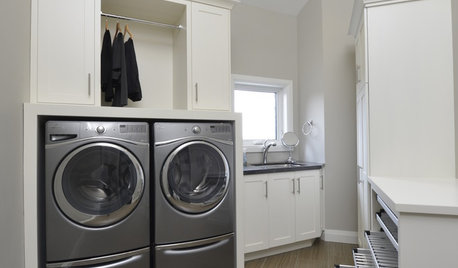








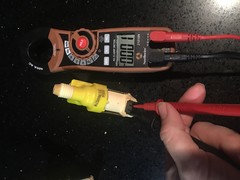
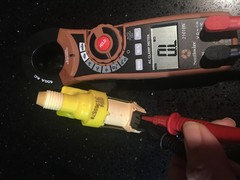
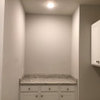
dadoes